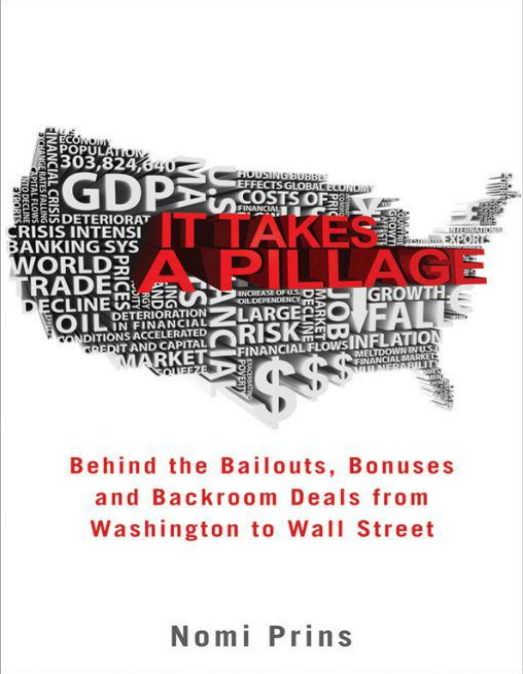It Takes a Pillage: Behind the Bailouts, Bonuses, and Backroom Deals from Washington to Wall Street by Nomi Prins

1
Where’d the Bailout Money Go, Exactly?
Behind every great fortune, there is a crime.
—Honoré de Balzac
Once President George W. Bush took office on January 20, 2001, he
appointed a string of his buddies to the treasury secretary position. The
first was Paul H. O’Neill, the former chairman and CEO of the aluminum
producer Alcoa, who served during the mini recession between 2001 and
2002. Then came John Snow, the former chairman and CEO of the
transportation company CSX, who served from February 2003 to June
2006.
These men were rarely seen doing very much of anything.
Treasury Secretary Paul O’Neill basically played the role of the
administration’s optimist during a spate of corporate scandals. On February
5, 2002, right smack between the Enron and WorldCom scandals, O’Neill
testified before the Senate Finance Committee on how to strengthen the
economy. Even as the country was in the midst of a recession, he said, “I
believe we always have untapped potential that can be unleashed to spread
prosperity throughout the nation. Never has that been more true than right
now.” O’Neill was later pushed out of his job because he spoke out against
Bush’s tax cuts and war policy.
John William Snow spent his time extolling free market virtues and
supporting Bush’s tax cuts. He rode into his post on the wave of a
unanimous Senate confirmation on February 3, 2003. Back then, the
economy looked rosy—on its shell. Gross domestic product was bustling
again, up 6.1 percent in the last half of 2003, the fastest growth rate in two
decades. That’s what war, rising oil prices, and a burgeoning housing-loan
bubble will do for you!
Snow enthused, “This country’s free market system
is strong, and the envy of the world.”
But it takes a banker to make a real difference—to really misuse the
country’s money with appropriate flair and deception.
That’s what former Goldman Sachs chairman and CEO Henry (aka
Hank) Paulson did. Though politically on the other side of the aisle from
the likes of Robert Rubin, he was part of the same Goldman fraternity and
espoused its free market, deregulatory, competitive-to-the-point-of-
destruction philosophy. Which goes to show you that money trumps
political party affiliation, and Wall Street heritage trumps both.
At Paulson’s confirmation hearing on June 27, 2006, he addressed “some
of the steps that could be taken to achieve a stronger and more competitive
U.S. economy.” (Note: When Paulson and his ilk use the word competitive,
they mean reckless business practices and the absence of cumbersome
restrictions on their viability. In reality, competition between financial
institutions drives them to make profits out of the most esoteric securities
and behaviors, while merging to dangerous levels of concentration.)
In addition to “maintaining and enhancing the flexibility of our capital
and labor markets,” Paulson promised to prevent “creeping regulatory
expansion from driving jobs and capital overseas.” He was good, that
Paulson. Regulation equals jobs going overseas. No one wants to lose his or
her job. Ergo, no one should want regulation. Good thing he prevented us
from losing our flexibility, jobs, and capital.
His actions helped create the economic crisis that began a couple of years
later, when deregulated banks leveraged their solid assets, such as citizen
deposits, into oblivion, all in the name of competition. But at least his
friends on Wall Street were freed from the shackles of regulation.




